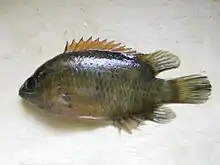
Taxonavigation
| Taxonavigation: Nandoidei |
|---|
|
Superregnum: Eukaryota |
Familia: Pristolepididae
Genus: Pristolepis
Species: Pristolepis pentacantha
Name
Pristolepis pentacantha Plamoottil, 2014
- Holotype: ZSI FF 5191 [ex STC/DOZ 82].
- Paratypes: ZSI FF 5192 [ex STC/DOZ 83 (1)].
Type locality: Bavali, Kabani River, Wayanad, Kerala, India.
Etymology: The specific epithet pentacantha was taken from two Greek words, pente meaning five and akantha meaning thorn, refers to five spines present in the anal fin of the new fish.
References
Primary references
- Plamoottil, M. 2014. Pristolepis pentacantha, a new fish species (Perciformes: Pristolepidae) from Kerala, India. International Journal of Scientific Research 3(5): 552–554. Reference page.
Links
- Pristolepis pentacantha in FishBase,
Froese, R. & Pauly, D. (eds.) 2022. FishBase. World Wide Web electronic publication, www.fishbase.org, version 06/2022. - Pristolepis pentacantha in Catalog of Fishes, Eschmeyer, W.N., Fricke, R. & van der Laan, R. (eds.) 2022. Catalog of Fishes electronic version, accessed on May 31, 2021.
- Pristolepis pentacantha in the World Register of Marine Species, accessed on May 31, 2021